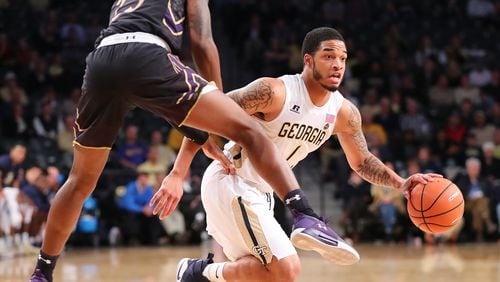Desperate for more offensive production, Georgia Tech has what looks like a fairly dependable option suiting up in the No. 1 jersey, guard Tadric Jackson.
More specifically, coach Josh Pastner wants him to drive more to the basket and take fewer – maybe not any – 3-pointers.
“Don’t shoot any more 3’s,” Pastner said Tuesday. “Why shoot any 3’s? There’s no need to.”
As Tech goes into its ACC home opener against Miami on Wednesday night at McCamish Pavilion, the numbers offer their strong support. Jackson is one of the country’s best at driving to the basket and a subpar 3-point shooter, but 3-point shots constitute a little more than a quarter of his field-goal attempts. Pastner brought up this coaching point following Tech’s loss to Notre Dame on Saturday, when Jackson was 7-for-10 from inside the 3-point arc and 0-for-3 outside of it.
“It’s just there’s no need to settle (for a 3-pointer),” Pastner said. “He should never settle. He needs to be an attack guy.”
After the Notre Dame game, Jackson’s 2-point field-goal percentage improved to 63.3 percent (57-for-90). His 2-point shots are a vastly better value play than his 3-point attempts, of which he’s making 21.2 percent (7-for-33).
Among guards who have played taken at least 60 shots inside the 3-point arc, Jackson was ranked 14th nationally in 2-point field-goal percentage and second in the ACC as of Tuesday, according to sports-reference.com. He wasn’t doing it by being modest. Of players in the top 14, only four had taken more two-point shots than Jackson.
Of the 13 ahead of him, Jackson is shorter than all of them at 6-foot-2. Beyond his quickness and leaping ability, Jackson has an uncanny skill for lofting shots over taller players, contorting his body in traffic, double pumping and rising up for fadeaways and floaters. In transition and in the half court, he consistently gets soft shots up at the basket that bank off the glass or roll around on the rim before falling through.
“This is something that’s just God-given,” Jackson said. “I’ve been able to have that ability to just score at will. It’s just always been natural to finish around the basket. It’s something that’s my strength.”
Tech’s teammates can attest to it by virtue of their own efficiency at making two-point shots, or lack thereof.
His teammates are shooting 44 percent from 2-point range. Making layups after contact has, again, been a daunting task for many of them. But Jackson came through in such a way in Tech’s biggest win of the season to date, making a contested buzzer-beating layup to beat Northwestern on Nov. 28.
Last season, Jackson made 50.4 percent of his 2-point shots (fourth among ACC guards who took at least 200 2-point shots) while he shot 32.5 percent from 3-point range. Averaging 12.1 points per game, a career high, he was runner-up for sixth man of the year in the ACC. Pastner compared him with Notre Dame’s All-ACC forward Bonzie Colson, an undersized power forward who ranks second in the ACC in scoring at 21.4 points per game.
“He’s just really good,” Pastner said of Jackson. “He’s got that ability – soft floaters and makes some hard-nosed plays.”
Through 13 games, Jackson is averaging 15.8 points per game, second on the team and 10th in the ACC. He likely could give his team a few more points with more forays to the rim and fewer jumpers from beyond the arc. His driving game can impact the offense beyond his scoring, as Jackson also has a keen understanding of angles as a passer and is among the more creative distributors on the team. Tech needs all of the help it can get on offense. The Jackets are ranked 210th nationally and last in the ACC in adjusted offensive efficiency (KenPom).
“He wants me to do this (drive to the basket) until they stop me from doing that,” Jackson said. “He’s like, if you can score 100 points scoring two points (at a time), why stop doing that?”
Jackson’s relative inefficiency beyond the arc makes it all the more worthwhile. Among players who have taken at least 25 3-pointers this season, Jackson’s 21.2 percent rate is 65th lowest nationally and third lowest in the ACC. Jackson doesn’t consider Pastner to be banning him from 3-pointers.
“If you got up and shoot the ball, you’ve got to be man enough to knock down the 3,” he said.
Indeed, Pastner said that there will be times when he’s OK with Jackson taking a 3 – when the ball is rotated to him and he’s wide open with his feet set.
“It’s basketball – you’re going to shoot it,” he said. “But it’s the discipline of just turning it down and getting a 2-point shot.”
About the Author







